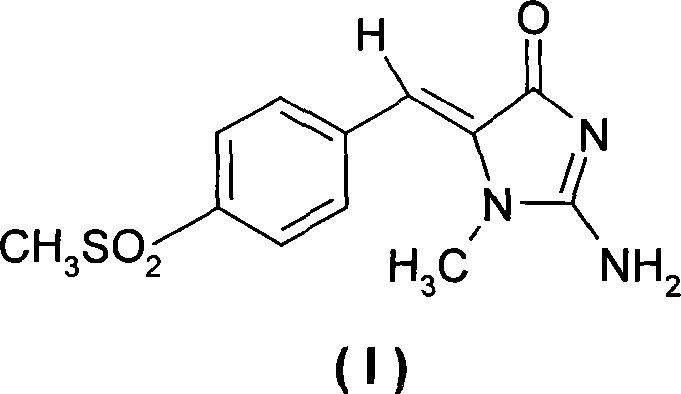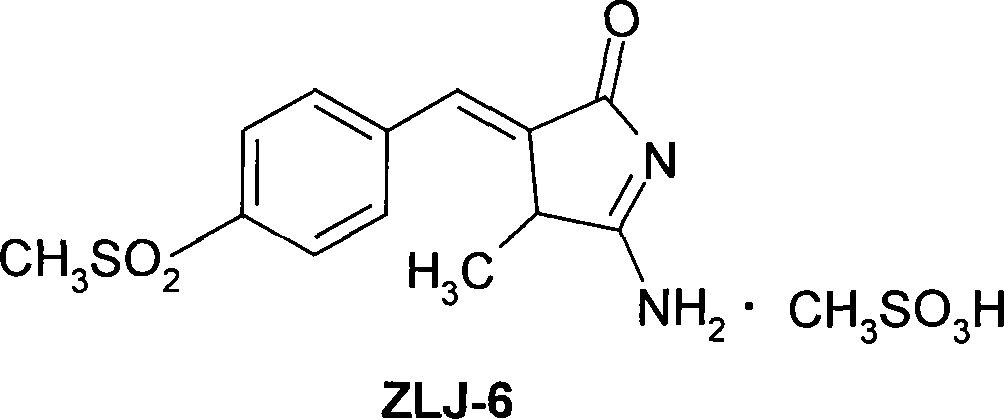Use of imidazolone compounds for treating cardiovascular and cerebrovascular diseases
A technology for cardiovascular and cerebrovascular diseases and cerebrovascular diseases, applied in the field of medicine, can solve problems such as adverse reactions, unfavorable confrontation and balance, and damage to gastric mucosa
- Summary
- Abstract
- Description
- Claims
- Application Information
AI Technical Summary
Problems solved by technology
Method used
Image
Examples
Embodiment 1
[0015] In vitro antiplatelet aggregation test
[0016] For male SD rats, the common carotid artery was isolated under anesthesia, blood was collected, and anticoagulated with heparin. Prepare platelet-rich plasma (PRP) and platelet-poor plasma (PPP) according to the literature (Xu Shuyun, Pharmacological Experimental Methodology, Third Edition, 2001: 1281), centrifuge the anticoagulated blood at 150×g for 10 minutes, and suck out the upper layer of plasma, which is PRP; the remaining blood was centrifuged at 3000×g for 15 minutes, and the supernatant was taken as PPP. Adjust the number of platelets in PRP with PPP to 5×10 8 / ml. Different inducers ADP (50 μM), arachidonic acid (300 μg·ml -1 ) and collagen (6μg·ml -1 ) to induce platelet aggregation, measure the maximum aggregation rate of platelets with NBY-6 platelet aggregation meter, and calculate the inhibition rate by formula: inhibition rate=(A model -A test ) / A model ×100%, the results showed that the compound ZL...
Embodiment 2
[0024] In vivo antiplatelet aggregation test
[0025] Male SD rats were randomly divided into model control group and aspirin group (30 mg·kg -1 ), CI-1004 (Darbufelone developed by Pfizer) group (5mg·kg -1 ) and ZLJ-6 high and low dose groups (10mg·kg -1 , 3mg·kg -1 ), 8 in each group. Continuous intragastric administration for 7 days. 2 hours after the last administration, blood was taken, anticoagulated with heparin, and the whole blood was allowed to stand still for 50-60 minutes. Take the blood sample and slowly inject it into a special siliconized test tube, add Tyrode's buffer, incubate at 37°C for 10 minutes, insert the sample tube into the measurement hole, put it into the stirring bar to stir, insert the electrode into the test tube until the digital display value is stable, and then adjust to zero. Then add aggregation inducer ADP solution (50 μM), arachidonic acid (300 μg·ml -1 ) or collagen (6μg·ml -1 ), timing. Record the maximum resistance value within 5...
Embodiment 3
[0031] Arteriovenous bypass thrombosis test in rats
[0032] Male SD rats were randomly divided into model control group and aspirin group (30 mg·kg -1 ), CI-1004 group (5mg·kg -1 ) and ZLJ-6 high and low dose groups (10mg·kg -1 , 3mg·kg -1 ), 8 in each group. Continuous intragastric administration for 7 days. Two hours after the last administration, the right common carotid artery and the left external jugular vein were separated under anesthesia, a 6 cm long and weighed silk thread was placed in the middle section of the polyethylene tube, and the lumen was filled with heparin saline, inserted and separated. In the out-flowing blood vessels, the silk thread was taken out and weighed after opening the blood flow for 15 minutes. The wet weight of the thrombus was subtracted from the total weight of the silk thread. Compared with the model group, the difference was significant (p<0.01), and the thrombus inhibition rate was equivalent to that of the positive control aspirin...
PUM
 Login to View More
Login to View More Abstract
Description
Claims
Application Information
 Login to View More
Login to View More - R&D
- Intellectual Property
- Life Sciences
- Materials
- Tech Scout
- Unparalleled Data Quality
- Higher Quality Content
- 60% Fewer Hallucinations
Browse by: Latest US Patents, China's latest patents, Technical Efficacy Thesaurus, Application Domain, Technology Topic, Popular Technical Reports.
© 2025 PatSnap. All rights reserved.Legal|Privacy policy|Modern Slavery Act Transparency Statement|Sitemap|About US| Contact US: help@patsnap.com


